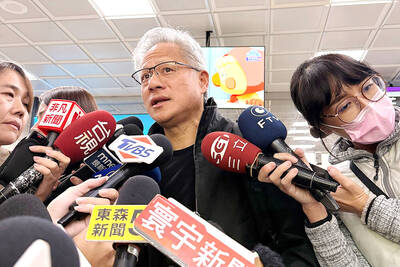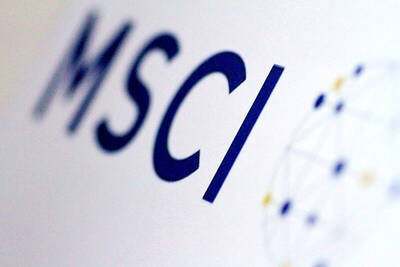Tourism revenue from Chinese visitors over the past months have been far below the expectations of the Tourism Bureau, with the number of visitors and their level of spending in Taiwan falling short of estimates, a survey conducted by the Institute for Business Development (IBD, 商業發展研究院) said.
IBD vice president Tu Tze-chen (杜紫宸) said at a press briefing yesterday that based on the monthly average of between 70,000 and 80,000 arrivals from China, it was estimated that the total for this year would be about 900,000, way below the Tourism Bureau’s forecast of 1.6 million visitors.
Through interviews with 28 experienced tour guides and the observations of IBD researchers who posed as tour guides to collect information on tourists’ consumption behavior, the institute drafted an analysis on the benefits to the tourism sector from the opening to Chinese visitors.
The report indicates that, to the disappointment of the travel sector, Chinese tourists each spend an average of NT$35,244 for an eight-day, seven-night stay in Taiwan, which means that revenues from Chinese tourists this year may not reach the Tourism Bureau’s projected NT$30 billion, which is based on an estimated average spending figure of NT$62,601 per person.
IBD researcher Lee Chu-yuan (李竺姮) said the average expenditure of Chinese tourists was far less than expected, partly because of cutthroat competition among travel agencies.
With the itineraries of low-budget tour groups mostly confined to night markets and cursory tours of scenic spots such as Alishan and Sun Moon Lake, Chinese tourists have hardly had the opportunity to appreciate Taiwan’s attractions and culture and therefore might not come again, Lee said.
The IBD analysis shows that 70 percent of the Chinese tourists to Taiwan over the past few months were people from rural areas, over 40 years of age, looking forward to fulfilling a dream of “going to Taiwan,” and expecting intensive tours during which they would see a wide variety of places.
Tu said Taiwan’s tourism sector should help Chinese tourists develop an appreciation for delicacies like Din Tai Fung (鼎泰豐) dumplings and for music stores, coffee shops, wineries and the tea houses of the Eslite (誠品) bookstore chain.
He said that both the government and the tourism sector should target white-collar workers and young people in China and design theme tours of special interest to them.
As many Taiwanese corporations are now preparing to hold year-end parties for their employees, Tu said, corporations with branches in China should consider inviting their Chinese employees to attend the celebrations in Taiwan. Such a gesture of company unity can also serve as a type of tourism promotion, he said.

PERSISTENT RUMORS: Nvidia’s CEO said the firm is not in talks to sell AI chips to China, but he would welcome a change in US policy barring the activity Nvidia Corp CEO Jensen Huang (黃仁勳) said his company is not in discussions to sell its Blackwell artificial intelligence (AI) chips to Chinese firms, waving off speculation it is trying to engineer a return to the world’s largest semiconductor market. Huang, who arrived in Taiwan yesterday ahead of meetings with longtime partner Taiwan Semiconductor Manufacturing Co (TSMC, 台積電), took the opportunity to clarify recent comments about the US-China AI race. The Nvidia head caused a stir in an interview this week with the Financial Times, in which he was quoted as saying “China will win” the AI race. Huang yesterday said

Nissan Motor Co has agreed to sell its global headquarters in Yokohama for ¥97 billion (US$630 million) to a group sponsored by Taiwanese autoparts maker Minth Group (敏實集團), as the struggling automaker seeks to shore up its financial position. The acquisition is led by a special purchase company managed by KJR Management Ltd, a Japanese real-estate unit of private equity giant KKR & Co, people familiar with the matter said. KJR said it would act as asset manager together with Mizuho Real Estate Management Co. Nissan is undergoing a broad cost-cutting campaign by eliminating jobs and shuttering plants as it grapples

The Chinese government has issued guidance requiring new data center projects that have received any state funds to only use domestically made artificial intelligence (AI) chips, two sources familiar with the matter told Reuters. In recent weeks, Chinese regulatory authorities have ordered such data centers that are less than 30 percent complete to remove all installed foreign chips, or cancel plans to purchase them, while projects in a more advanced stage would be decided on a case-by-case basis, the sources said. The move could represent one of China’s most aggressive steps yet to eliminate foreign technology from its critical infrastructure amid a

MORE WEIGHT: The national weighting was raised in one index while holding steady in two others, while several companies rose or fell in prominence MSCI Inc, a global index provider, has raised Taiwan’s weighting in one of its major indices and left the country’s weighting unchanged in two other indices after a regular index review. In a statement released on Thursday, MSCI said it has upgraded Taiwan’s weighting in the MSCI All-Country World Index by 0.02 percentage points to 2.25 percent, while maintaining the weighting in the MSCI Emerging Markets Index, the most closely watched by foreign institutional investors, at 20.46 percent. Additionally, the index provider has left Taiwan’s weighting in the MSCI All-Country Asia ex-Japan Index unchanged at 23.15 percent. The latest index adjustments are to